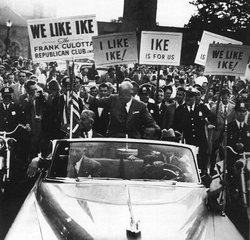U.S. presidential election, 1952
|
|
ElectoralCollege1952-Large.png
The U.S. presidential election of 1952 took place after several years of stalemate in the Korean War and a choppy economy. Incumbent President Harry S Truman decided not to run, so the Democratic Party instead nominated Governor Adlai Stevenson of Illinois. The Republican Party countered with war hero General Dwight D. Eisenhower and won in a landslide.
| Contents |
Nominations
Republican Party nomination
The fight for the Republican nomination was largely between General Dwight D. Eisenhower, as candidate of the party's more moderate eastern establishment (led by New York Governor Thomas E. Dewey, the party's nominee in 1944 and 1948), and Senator Robert A. Taft of Ohio, the candidate of the more conservative party regulars in the Midwest. The primaries had been split fairly evenly between the two men, and the nomination came down to the wire, but ultimately Eisenhower won the nomination based largely on the perception that he was a sure winner. To placate the party's conservative wing, Eisenhower chose as his running mate Senator Richard Nixon of California, best known for his pursuit of Alger Hiss. Other Republican candidates in this year were Governor Earl Warren of California and former Minnesota Governor Harold Stassen, who had both hoped to emerge as a compromise candidate in case of deadlock between Eisenhower and Taft.
Democratic Party nomination
The obvious candidate for the Democratic nomination was incumbent President Harry S. Truman. He was still eligible to the presidency in spite of the 1951 passage of the 22nd Amendment, which limited Presidents to two terms, because of that amendment's grandfather clause.
Truman entered 1952 with his popularity plummeting. The Korean War was dragging into its third year, Senator Joseph McCarthy's anti-Communist crusade was stirring public fears of an encroaching "Red Menace", and the disclosure of widespread corruption among federal employees rocked the administration. After losing the New Hampshire primary to Tennessee Senator Estes Kefauver, who had chaired a nationally televised investigation of organized crime in 1951, President Truman announced on March 29, 1952, that he would not seek re-election.
The Democratic Party was now largely demoralized, associated with the unpopularity of the Truman administration and lacking any obvious candidates. While Kefauver went on to win nearly all of the other primaries, most states still chose their delegates by state conventions, leaving party bosses in a position to choose the eventual nominee. Besides Kefauver, the leading contenders for the nomination were Ambassador Averell Harriman, Truman's pick and the choice of Harriman's voter rich home state of New York; Senator Richard Russell of Georgia as the candidate of the southern bloc; and Governor Adlai Stevenson of Illinois, who emerged as the choice of the mainline party leadership. Other minor or favorite son candidates included Oklahoma Senator Robert Kerr, Vice President Alben Barkley, Governor Paul A. Dever of Massachusetts, Senator Hubert H. Humphrey of Minnesota, and Senator J. William Fulbright of Arkansas.
Governor Adlai Stevenson had repeatedly declined to run but was eventually drafted as the Democratic nominee on the strength of his eloquent keynote speech at the convention.
On the first ballot, Kefauver was in the lead, receiving 340 votes to Stevenson's 273, Russell's 268, and Harriman's 123. But as favorite son candidates dropped out, Stevenson began to close, and on the third ballot he was boosted when Harriman dropped out and threw his support to Stevenson. To placate the south at the nomination of a northern liberal, Alabama Senator John J. Sparkman (a relative liberal by Alabama standards) was chosen as Stevenson's running mate.
General election
Campaign
Eisenhower campaigned by attacking the failures of the outgoing Administration, and promising to go to Korea and resolve the war. His residual popularity as a World War II commander made him the leader throughout the campaign.
Both campaigns made use of television ads. A notable ad for "Ike" Eisenhower was an issue-free feel-good animated cartoon with a soundtrack song by Irving Berlin called I Like Ike.
One notable event of the campaign was a scandal that emerged when Vice Presidential candidate Nixon was accused of receiving various undeclared gifts from wealthy contributors. It must here be said that the democratic presidential nominee Adlai Stevenson had problems with his own campaign contributions. For a while it appeared that Nixon might be dropped from the campaign, but he gave a tearful televised speech (the "Checkers Speech") in which he defended his political expenses and told the public about a dog named "Checkers" that he had received from a contributor, and how much his children loved it. This speech defused the issue and recovered Nixon's support.
The election was held on November 4, 1952, and Eisenhower won a decisive victory, sweeping every region but the South.
Results
Template:Start U.S. presidential ticket box Template:U.S. presidential ticket box row Template:U.S. presidential ticket box row Template:End U.S. presidential ticket box (a) Template:U.S. popular vote total disclaimer
Source: U.S. Office of the Federal Register (http://www.archives.gov/federal_register/electoral_college/scores.html#1952)
See also
Template:Uspresidentialelections
Reference
External link
- 1952 State-by-state Popular vote (http://www.multied.com/elections/1952state.html)
- The Living Room Candidate: Presidential Campaign Commercials: 1952 – 2004 (http://livingroomcandidate.movingimage.us)

